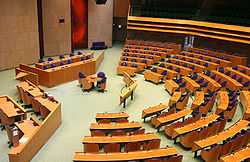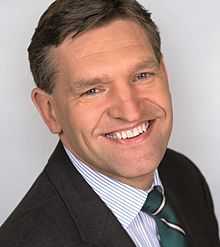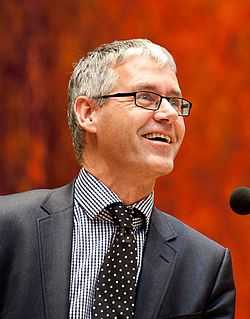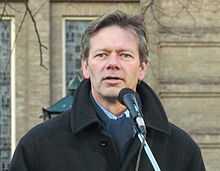House of Representatives (Netherlands)
| The House of Representatives Tweede Kamer der Staten-Generaal | |
|---|---|
| States General of the Netherlands | |
 | |
| Type | |
| Type |
Lower House |
| Leadership | |
President | |
| Structure | |
| Seats | 150 |
 | |
Political groups |
Opposition Parties (74) |
| Elections | |
| Party-list proportional representation | |
Last election | 12 September 2012 |
| Meeting place | |
 | |
|
Binnenhof The Hague, Netherlands | |
| Website | |
|
House of Representatives Tweede Kamer | |
The House of Representatives (Dutch: Tweede Kamer der Staten-Generaal [ˈtʋeːdə ˈkaːmər dɛr ˈstaːtə(n) ˌɣeːnəˈraːl], or simply: Tweede Kamer, literally, Second Chamber) is the lower house of the bicameral parliament of the Netherlands, the States General, the other one being the Senate. It has 150 seats which are filled through elections using a party-list proportional representation. It sits in the Binnenhof in The Hague.
Name
Although this body is called the "House of Representatives" in English, this is not a direct translation of its Dutch name, the "Second Chamber" or more colloquially just the "Chamber". Rather than "representatives" (afgevaardigden), members of the House are referred to as Tweede Kamerlid ("member of the Second Chamber").
Functions
The House of Representatives is the main chamber of parliament, where discussion of proposed legislation and review of the actions of the cabinet takes place. Both the Cabinet and the House of Representatives itself have the right to propose legislation; the House of Representatives discusses it and, if adopted by a majority, sends it on to the Senate. Review of the actions of the cabinet takes the form of formal interrogations, which may result in motions urging the cabinet to take, or refrain from, certain actions. No individual may be a member of both parliament and cabinet, except in a caretaker cabinet that has not yet been succeeded when a new House is sworn in.
The House of Representatives is also responsible for the first round of selection for judges to the Supreme Court of the Netherlands. It submits a list of three names for every vacant position to the Government. Furthermore, it elects the Dutch Ombudsman and his subsidiaries.
Elections
The maximum term of the House of Representatives is four years. Anybody eligible to vote in the Netherlands also has the right to establish a political party and contest elections for the House of Representatives (see Political parties of the Netherlands). Elections are called when the government loses parliament's confidence, the governing coalition breaks down, the term of the House of Representatives expires or when no governing coalition can be formed.
Parties wanting to take part must register 43 days before the elections, supplying a nationwide list of at most 50 candidates (80 if the party already has more than 15 seats). Parties that do not have any sitting candidates in the House of Representatives must also pay a deposit (11,250 euro for the November 2006 elections, for all districts together) and provide 30 signatures of support from residents of each of the 20 electoral districts in which they want to collect votes. The candidate lists are placed in the hands of the voters at least 14 days before the election. Two or more parties can agree to combine their separate lists (this is known as a 'list combination' or lijstencombinatie), which increases the chance of winning a remainder seat. Each candidate list is numbered, with the person in the first position known as the lijsttrekker ("list puller"). The lijsttrekker is usually appointed by the party to lead its election campaign. The lijsttrekker of the party receiving the most seats will often become the Prime Minister. Parties may choose to compete with different candidate lists in each of the 19 electoral districts, but as seats are allocated on national rather than district level, most parties have almost identical lists in all districts with candidates running nationwide. Only large parties usually have some regional candidates at the bottom of their lists.
Citizens of the Netherlands aged 18 or over have the right to vote; exceptions are: 1) prisoners serving a term of more than one year are excluded; 2) those who have been declared incapable by court because of insanity are also excluded. A single vote can be placed on any one candidate. Many voters select one of the lijsttrekkers (Jan Peter Balkenende, for example, received 2,198,114 of the CDA's 2,608,573 votes in the November 2006 elections), but alternatively a preference vote may be made for a candidate lower down the list.
Once the election results are known, the seats are allocated to the parties. The number of valid national votes cast is divided by 150, the number of seats available, to give a threshold for each seat (the kiesdeler). Each party's number of votes is divided by this threshold to give an initial number of seats. Any party that received fewer votes than the threshold (i.e., less than one in 150 of the total votes cast) fails to gain representation in the House of Representatives, thus the threshold is always at 0.67% of the total number of valid national votes (roughly one seat for every 50,000 votes). This is one of the lowest thresholds for national parliament elections in the world. In 1977, for instance, one party gained a seat despite winning only 0.77% of the vote. Any party that received more than 75% of the threshold will have its deposit refunded.

After the initial seats are allocated, the remainder seats are allocated using the D'Hondt method of largest averages. This system favours slightly the larger parties. List combinations compete for the remainder seats as one list of the combined size of all parties in the combination, thus having more chance to gain remainder seats. Afterwards, the seats are allocated to the parties within the list combination using the largest remainder method.
Once the number of seats allocated to each party is known, in general they are allocated to candidates in the order that they appear on the party's list. (Hence, before the elections, the candidates near the top may be described as in an electable position, depending on the number of seats that the party is likely to obtain.) At this stage, however, the preference votes are also taken into account. Any candidate receiving more than one quarter of the threshold on personal preference votes (the 'preference threshold' or voorkeursdrempel, 0.1675% of the total number of valid votes), is considered elected in their own right, leapfrogging candidates higher on the list. In the November 2006 elections, only one candidate received a seat exclusively through preference votes, while 26 other candidates reaching the preference threshold were already elected based on their position on the list. If a candidate cannot take up the position in parliament (e.g., if they become a minister, decide not to enter parliament, or later resign) then the next candidate on the list takes their place.
After all seats are allocated a government is formed, usually based on a majority of the seats. Since 2012, the House of Representatives appoints an informateur (in previous years the informateur was appointed by the monarch), who checks out possible coalitions, and formateur, who leads formation negotiations. At the end of the negotiations, the formateur becomes prime minister. All cabinet members must resign from parliament, as the constitution does not allow a cabinet member to hold a seat in the House of Representatives.
Due to the nationwide party-list system and the low election threshold, it is nearly impossible for one party to win the 75 seats needed for a majority in the House of Representatives. Indeed, since the current party-list proportional representation system was introduced in 1918, no party has even approached the number of seats necessary for an outright majority. The highest proportion of seats was 54 out of 150, obtained by the CDA in 1986 and 1989.[1] Between 1891 and 1897, the Liberal Union was the last party to have an absolute majority of seats in the House of Representatives. All Dutch governments since then have been coalitions of two or more parties.
Current situation
The Dutch general election of 2012 was held on Wednesday, September 12, 2012, and followed the call for new elections after the fall of the First Rutte cabinet. The formation talks led to the installation of the Second Rutte cabinet, composed of the People's Party for Freedom and Democracy and the Labour Party on November 5, 2012.
| Parliamentary leaders | Political Party | Seat(s) | Parliamentary leader since | Member of the House of Representatives since |
Previous service as Member of the House of Representatives |
Previous service as Parliamentary leader | |||
|---|---|---|---|---|---|---|---|---|---|
 |
|
|
(2 years, 179 days) |
(2 years, 221 days) |
(3 years, 318 days) | ||||
.jpg) |
|
|
(3 years, 40 days) |
(12 years, 89 days) | |||||
 |
|
|
(5 years, 55 days) |
(8 years, 150 days) | |||||
 |
|
|
(4 years, 199 days) |
(12 years, 341 days) | |||||
.jpg) |
|
|
(8 years, 157 days) |
(12 years, 307 days) |
(3 years, 271 days) | ||||
.jpg) |
|
|
(8 years, 157 days) |
(8 years, 150 days) | |||||
 |
|
|
(4 years, 18 days) |
(12 years, 161 days) |
(1 years, 98 days) |
(3 years, 115 days) | |||
 |
|
|
(2 years, 203 days) |
(2 years, 221 days) |
(1 years, 26 days) | ||||
 |
|
|
(4 years, 324 days) |
(16 years, 345 days) | |||||
 |
|
|
(2 years, 349 days) |
(2 years, 349 days) |
(5 years, 55 days) |
(5 years, 62 days) | |||
 |
|
|
(231 days) |
(231 days) |
(1 years, 16 days) |
(1 years, 23 days) | |||
| |
(Expelled from PVV) |
|
(1 years, 14 days) |
(4 years, 316 days) | |||||
 |
(Split from PvdA) |
|
(162 days) |
(2 years, 170 days) | |||||
_Klein.jpg) |
(Split from 50+) |
|
(331 days) |
(1 years, 205 days) | |||||
| |
(Split from PVV) |
|
(1 years, 40 days) |
(4 years, 316 days) | |||||
| |
(Expelled from VVD) |
|
(35 days) |
(35 days) |
(1 years, 330 days) (257 days) | ||||
| President of the House of Representatives |
Political Party | President of the House of Representatives since |
Member of the House of Representatives since | |
|---|---|---|---|---|
 |
|
(2 years, 216 days) |
(12 years, 89 days) | |
| First Deputy President of the House of Representatives |
Political Party | First Deputy President of the House of Representatives since |
Member of the House of Representatives since |
Previous service as Member of the House of Representatives |
| |
|
(2 years, 179 days) |
(8 years, 59 days) |
(8 years, 195 days) |
| Second Deputy President of the House of Representatives |
Political Party | Second Deputy President of the House of Representatives since |
Member of the House of Representatives since | |
 |
|
(4 years, 310 days) |
(8 years, 150 days) | |
| Third Deputy President of the House of Representatives |
Political Party | Third Deputy President of the House of Representatives since |
Member of the House of Representatives since | |
| |
|
(2 years, 215 days) |
(2 years, 234 days) |
(1 years, 50 days) (3 years, 108 days) |
| Fourth Deputy President of the House of Representatives |
Political Party | Fourth Deputy President of the House of Representatives since |
Member of the House of Representatives since |
Previous service as Member of the House of Representatives |
| |
|
(4 years, 303 days) |
(8 years, 150 days) | |
| Fifth Deputy President of the House of Representatives |
Political Party | Fifth Deputy President of the House of Representatives since |
Member of the House of Representatives since | |
 |
|
(2 years, 221 days) |
(4 years, 316 days) | |
| Sixth Deputy President of the House of Representatives |
Political Party | Sixth Deputy President of the House of Representatives since |
Member of the House of Representatives since | |
 |
|
(2 years, 221 days) |
(8 years, 150 days) | |
| Seventh Deputy President of the House of Representatives |
Political Party | Seventh Deputy President of the House of Representatives since |
Member of the House of Representatives since | |
 |
|
(2 years, 174 days) |
(6 years, 132 days) | |
![Azure, billetty Or a lion with a coronet Or armed and langued Gules holding in his dexter paw a sword Argent hilted Or and in the sinister paw seven arrows Argent pointed and bound together Or. [The seven arrows stand for the seven provinces of the Union of Utrecht.] The shield is crowned with the (Dutch) royal crown and supported by two lions Or armed and langued gules. They stand on a scroll Azure with the text (Or) "Je Maintiendrai" (French for "I will maintain".)](../I/m/State_coat_of_arms_of_the_Netherlands.svg.png) |
| This article is part of a series on the politics and government of the Netherlands |
|
|
|
Local government
|
|
|
Related topics
|
|
Politics portal |
| Party | Lijsttrekker | Votes | % | +/– | Seats | +/– | |||
|---|---|---|---|---|---|---|---|---|---|
| People's Party for Freedom and Democracy | Mark Rutte | 2,504,948 | 26.6 | +6.1 | 41 | +10 | |||
| Labour Party | Diederik Samsom | 2,340,750 | 24.8 | +5.2 | 38 | +8 | |||
| Party for Freedom | Geert Wilders | 950,263 | 10.1 | -5.4 | 15 | -9 | |||
| Socialist Party | Emile Roemer | 909,853 | 9.7 | -0.2 | 15 | 0 | |||
| Christian Democratic Appeal | Sybrand van Haersma Buma | 801,620 | 8.5 | -5.1 | 13 | -8 | |||
| Democrats 66 | Alexander Pechtold | 757,091 | 8.0 | +1.1 | 12 | +2 | |||
| ChristianUnion | Arie Slob | 294,586 | 3.1 | -0.1 | 5 | 0 | |||
| GreenLeft | Jolande Sap | 219,896 | 2.3 | -4.3 | 4 | -6 | |||
| Reformed Political Party | Kees van der Staaij | 196,780 | 2.1 | +0.4 | 3 | +1 | |||
| Party for the Animals | Marianne Thieme | 182,162 | 1.9 | 0.6 | 2 | 0 | |||
| 50PLUS | Henk Krol | 177,631 | 1.9 | - | 2 | - | |||
| Pirate Party | Dirk Poot | 30,600 | 0.3 | +0.2 | 0 | 0 | |||
| Party for Human and Spirit | Lea Manders | 18,310 | 0.2 | -0.1 | 0 | 0 | |||
| Sovereign Independent Pioneers Netherlands | Johan Oldenkamp | 12,982 | 0.1 | – | 0 | – | |||
| Party of the Future | Johan Vlemmix | 8,194 | 0.1 | – | 0 | – | |||
| Democratic Political Turning Point | Hero Brinkman | 7,363 | 0.1 | – | 0 | – | |||
| Libertarian Party | Toine Manders | 4,163 | 0.0 | – | 0 | – | |||
| Netherlands Local | Ton Schijvenaars | 2,842 | 0.0 | – | 0 | – | |||
| Liberal Democratic Party | Sammy van Tuyll van Serooskerken | 2,126 | 0.0 | – | 0 | – | |||
| Anti-Europe Party | Arnold Reinten | 2,013 | 0.0 | – | 0 | – | |||
| Political Party NXD | Anil Samlal | 62 | 0.0 | – | 0 | – | |||
| Total valid votes | 9,424,235 | 100 | – | 150 | – | ||||
| Invalid/blank votes | 37,988 | 0.4 | |||||||
| Total | 9,462,223 | 100 | |||||||
| Registered voters/turnout | 12,689,810 | 74.6 | |||||||
| Source: Verkiezingsuitslagen, Kerngegevens Tweede Kamerverkiezing 2012. Nederlandse Kiesraad. 17 September 2012. Retrieved 2 October 2012. | |||||||||
Historical compositions

Until 1956, there were 100 seats. This was expanded to 150 seats, which is the current number.
To give an overview of the history of the House of Representatives, the figure on the right shows the seat distribution in the House from the first general elections after WWII (1946) to the current situation. The left-wing parties are towards the bottom, the Christian parties in the centre, with the right-wing parties towards the top. Occasionally, single-issue (or narrow-focus) parties have arisen, and these are shown at the extreme top. Vertical lines indicate general elections. Although these are generally held every four years, the resulting coalition governments do not always finish their term without a government crisis, which is often followed by fresh elections. Hence the frequent periods shorter than four years.
References
- ↑ "Historische zetelverdeling Tweede Kamer". Wikipedia (Netherlands). Retrieved 4 April 2014.
External links
| Wikimedia Commons has media related to House of Representatives of the Netherlands (Tweede Kamer). |
- (English) Official site
- (Dutch) Official site
- (English) Virtual tour of the houses of parliament
- (Dutch) Seat allocation in the House of Representatives. Click the diagram on the left to see names and photos of all representatives per section.
- (Dutch) Official site for archives since 1995
| |||||||||||||||||
| ||||||||||||||||||||||||||||||||||||||||||
| ||||||||||||||||||||||